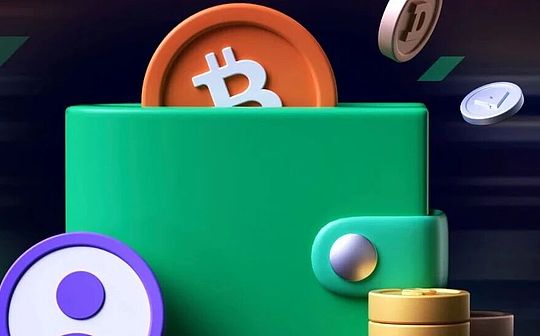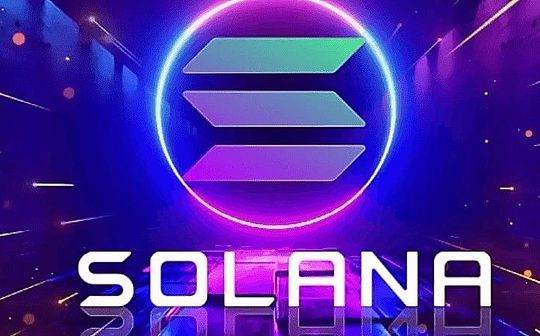
Author: Saurabh, Joel John, Siddharth, Source: Vernacular Blockchain
In 2022, as the topic of the SBF and FTX platforms skyrocketed, Solana also became a hot chain in the encryption industry, but the collapse of FTX also collapsed the entire ecosystem of Solana.
SOL plunged from $ 236 to $ 13 in a few weeks.Investment institutions suggest that startups do not choose Solana, and instead built on Ethereum virtual machines (EVM).Subsequently, some well -known projects moved from Solana to other chains.However, a year later, as shown in the figure below, Solana rebounded and surpassed his peers.
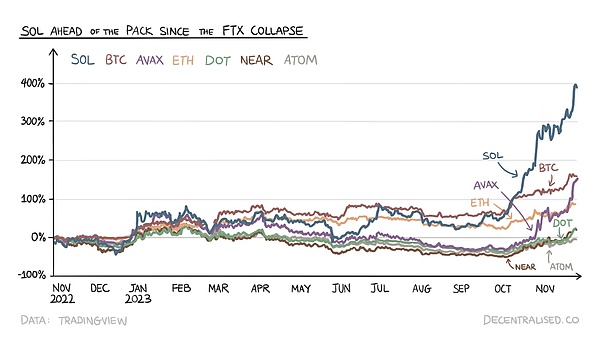 From the end of 2022 to 2023
From the end of 2022 to 2023
People like to listen to the stories of Dongshan’s resurgence. This article discusses what choices have been made from the bear market in 2023, and where the design differences that make them have made it a head -to -head chain.
01ClientmanySample
The founder of Solana Anatoly and team members have a wealth of background in the traditional mobile communications industry.As programmers, they have worked in Qualcomm for more than ten years and witnessed the influence of Moore’s law (hardware capacity doubled every two years).Solana’s construction is different from Bitcoin and Ethereum. It does not limit the requirements of node hardware.
Bitcoin and Ethereum are relatively mature networks and have more client diversity.But why is the client diversity so important?Think so, a decentralized network, you hope that all functions are relatively decentralized. If more than 66% of the network uses a single node client, and the node issues an error update or choose to synchronize the block in the order of errors.It will affect the function of the blockchain.For which block is first approved, there may be consensus issues. Ethereum and Bitcoin have actively optimized client diversity in the past.
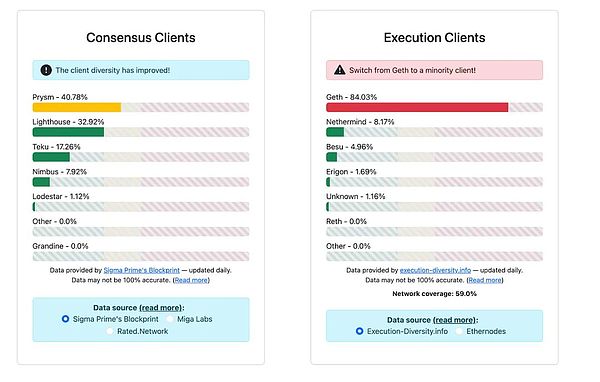 Consensus client and execution client, Source: https://clientdiversity.org/Methodology/
Consensus client and execution client, Source: https://clientdiversity.org/Methodology/
Solana experienced three major network failures and several performance declines in 2022. In 2023, a failure also had a failure in 2023EssenceThese stops are mainly caused by consensus issues.Although low transaction fees are beneficial to users, it also makes it easier to send a large number of transactions or perform rejection services (DDOS) attacks.
When a block is proposed, the verified person will receive an information package (in the block) to independently verify its correctness and confirm each other to achieve consensus.However, the consensus information is lost when the verifier is lagging behind when processing the information package.
Firedancer has created a message framework that bypasses some centers and reduces the delay of the network.Since Firedancer is built by a different team from scratch, it may not carry the same errors as the Solana Labs client.Therefore, the same error will not affect these clients at the same time.Ideally, the verifications will run a main and minor client, and the secondary client will be used as a backup.
A chain with a powerful DEFI ecosystem requires a 100%normal operation time, so Solana needs a more powerful client infrastructure.The main reasons for the pause of Solana is the lack of congestion control and network processing delay.Several network upgrades have improved the abnormality of the verification device to the torrent of transaction and achieved better congestion control.
Solana admits that the diversity of the client is an improved job.Like the previous Ethereum and Bitcoin, these things take time.One of the signs of improvement is the percentage of asset running through the Jito-Solana client.Although the Jito Solana client is not helpful in implementing redundancy, it shows that the verifications will run different clients when available.
As more clients like Firedancer and SIG are launched, we should see a decrease in dependence on the Solana Labs client in the future.The best proportion of individual clients is about 33%.Therefore, there are still jobs to do.
 The percentage of pledge running through the Jito-Solana client within a period of time
The percentage of pledge running through the Jito-Solana client within a period of time
02Cost model
The health cost market is the key factor of prosperous blockchain, just as it is displayed in Bitcoin and Ethereum chain.In 2024, Bitcoin’s block rewards will be reduced from 6.25 BTC to 3.125 BTC of each block.If we assume that Bitcoin producers need the same incentives, to maintain the existing incentive level, the price must be doubled, or the cost income must make up for the loss of the reward halving.Due to the inscriptions, the increased costs have brought hope to block producers and Bitcoin safety budgets.
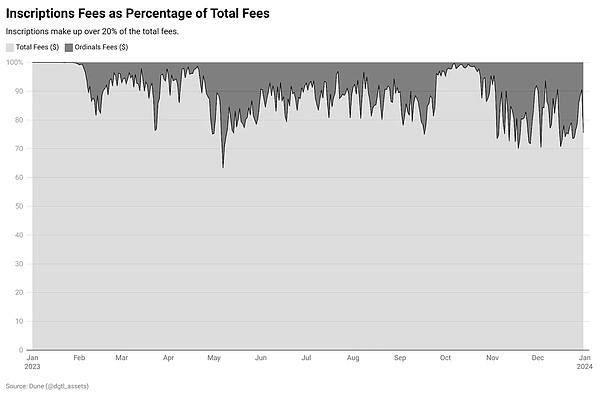 The percentage of inscription casting costs is about 20%
The percentage of inscription casting costs is about 20%
Through EIP1559, Ethereum changed the monetary policy, and ensured that ETH’s inflation was maintained under control by adding a destruction mechanism.Monetary systems and dynamic expenses have played an important role in stable chain and adjustment of stakeholders’ incentives, and other chains also hope to achieve the same position.
Solana has no priority at the initial stage, and the cost of each transaction is fixed at 5000 LAMPORTS(In the Solana blockchain, Lamports is the smallest unit, similar to WEI in Ethereum or Satoshis in Bitcoin).Solflare was the first wallet to achieve priority costs on Solana in January 2023.The cost is crucial, the reason is as follows:
1) Resisting spam attack
2) Verification device compensation
3) Improvement of the economic stability of the agreement.As costs increase, inflation can be reduced.
Like Ethereum’s EIP1559, Solana destroyed 50%of the cost and the remaining 50%of the verification device was owned.This standard was set in 2021 and has not changed so far.
 Basic expenses are destroyed and priority costs are given.Source: umbra Research
Basic expenses are destroyed and priority costs are given.Source: umbra Research
On Ethereum, the transaction is waiting in the memory pool before entering the block. Verivers will choose to pay the transaction with the highest payment fee for block packaging.The global memory pool was created by different authenticants that spread their respective memory pools.This is where the maximum extraction value (MEV) is generated.
Because the memory pool can see the verificationrs and the MEV searcher, searchists can recognize that they can perform front transactions and rear transactions to obtain profit transactions.Searchists are usually robots looking for MEV opportunities.For example, if someone purchases tokens A worth $ 1 million, the searchker can buy A before the transaction is completed and immediately sell it.
Unlike Ethereum, Solana is multi -threaded and can be traded in parallel.When the signature transaction arrives at the leader, the leaders verify them and randomly distribute them to the thread.Only when they are allocated to leaders’ local different threads, they are sorted according to the priority fees (that is, the transaction priority with the highest fees).
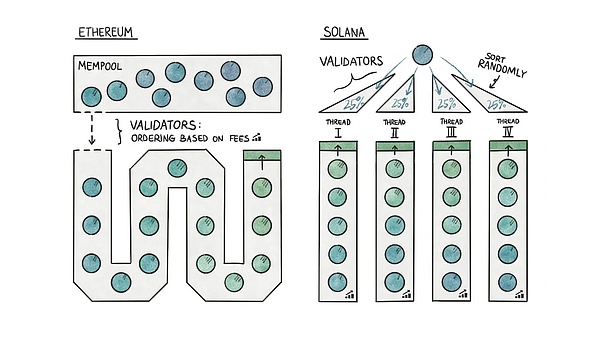 Different transaction processes of Ethereum and Solana
Different transaction processes of Ethereum and Solana
Solana had no priority costs.But now, wallets like Solflare allow users to pay priority fees.Priority costs have generated local or isolation fees market for Solana.Unlike Ethereum, the Solana transaction must indicate where they want to read and write a state.
Solana’s verifications know the status involved in the transaction before calculating.Solana transaction needs to specify specific information,This information helps Solana determine which status is becoming a hot spot.The total number of calculation units (CU) used in any hotspot is limited to within 25%(one of the four cores for SOLANA multi -threaded).This is to prevent updating the number of accounts in a block.
The hotspot is a specific smart contract or account that suddenly appears in a large amount of traffic.On the EVM network, a large amount of demand for a single application (such as Crypto Kitties) may lead to an increase in transaction costs of the entire network.On Solana, the number of CUs that can be used in each block of individual smart contracts/applications (such as Tensor or Jupiter) is limited to 25%.
In other words, transactions using any specific contract cannot occupy more than 25%of the block, that is, 12 million CU.All transactions that exceed this limit must wait for the next block.Therefore, if the usage of an independent application increases sharply, the entire network will not start paying more fees.Only transactions interacting with the application will see the increase in handling fees.This is how the localization handling market looks like.
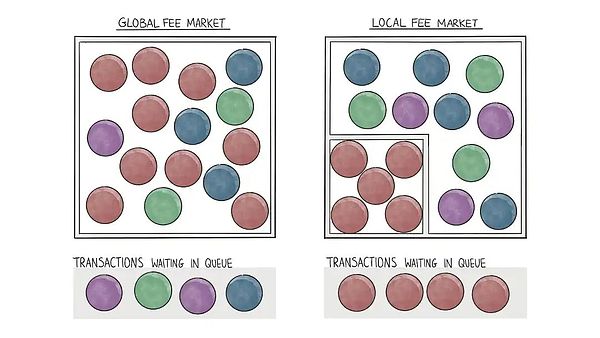
Different applications, even if there are Gas War, it will not affect other applications
What will happen if there are 4 or more hot spots?In this case, Solana looks like Ethereum.GAS battles may occur between the hot spots of competition, and the transaction with the highest handling fee will enter.The local expense market seems to be a beautiful solution to solve the problem of soaring fees.
How to operate in practice?There are still some problems with Solana’s expense market design:
First of all, the basic costs incurred by the current transaction are the same, whether it is token transfer, exchange or lightning loan.This is obviously not reasonable enough.The transaction should be cost according to the consumed computing resource (CU), although this is already considered.CU represents block space, so paying higher fees should be able to get more space.
Secondly, since there is no memory pool, the verified as the verification will only arranges transactions according to the cost after allocating to different threads, so higher cost transactions will not always succeed.This may lead to the next problem.
Third, Solana does not have a memory pool like Ethereum, so the higher priority cost does not guarantee that the transaction will be included in the blockEssenceTherefore, the best way to extract MEV for searchmen (those looking for MEV) is to bomb the network with multiple transactions, and hope that the verifier will choose one of them.On Solana, due to the low cost of transaction, this approach is relatively easy.
03Community atmosphere
Steve Ballmer once said: “The key to the success of NET is developers, developers, and developers.” When building a new ecosystem, this is the only meaningful measurement standard.The strong developer network builds applications, and then develops application scenarios, and eventually transformed into real users.Whether it is the mobile terminal, desktop end, cloud service or blockchain, developers are connected to correlation.
Therefore, I am curious about how many developers in the Solana ecosystem.However, it should be noted that due to the collapse of the FTX, most of the Solana ecosystem was initially hit.
Packy sarcastically mentioned in an article in 2022 that SBF is one of the characters of Solana as a character of a interesting ecosystem.When the FTX closed, the ecosystem lost one of the biggest supporters.The new Token is no longer listed, and the venture capitalists will no longer invest. Development talents may have flooded to other places to find resources.
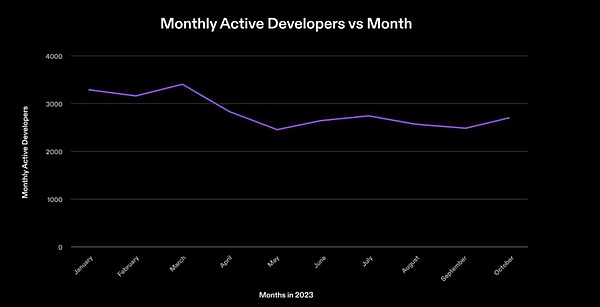 Solana’s monthly active developer in 2023
Solana’s monthly active developer in 2023
According to recent Solana data, about 3,000 developers have been developed on Solana over the past year.This number considers developers contributed to the public repository, excluding personnel developed in GitHub’s private repository.Considering the recent surge in SOL prices, more developers may turn to the ecosystem.With the influx of users (due to the rise in prices), this number may increase significantly.
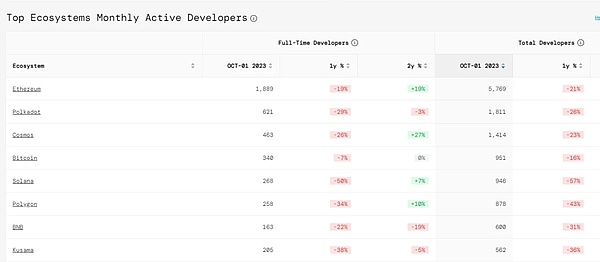 Each mainstream public chain has increased or decreased in the number of developers in January and October in the past three years.
Each mainstream public chain has increased or decreased in the number of developers in January and October in the past three years.
If we report this number with the developer of Electric Capital, the report states that in October 2023, there were more than 19,000 developers in the blockchain ecosystem, then developers on Solana accounted for about 15% of the entire ecosystem system.Essence
Compared with the traditional web2 ecosystem, Solana provides developers with lower cost and faster transactions, providing users with a better experience.With the development of consumer entry tool kits around Solana, more and more developers will build it on it.
To establish a sustainable ecosystem, it is important to benefit developers.Solana provides resources to developers who seriously build on them through platforms such as foundation, community hacker marathon, and platforms like SuperTeam Earn.The team raised nearly $ 600 million from the hacking marathon of the ecosystem.In addition, through AirDrop of developers, Solana has released a number of new talents, and they can build it without raising funds.
In 2022, Bonk distributed 5%AirDrop to developers.In addition, 20%are allocated to the existing NFT projects in the ecosystem, and 10%are allocated to artists and collectors.These 35%are now worth $ 450 million.Those Token developers holding them may achieve a profit of about $ 500,000 in Bonk’s December soaring in December, which is equivalent to a round of pre -seedling financing.
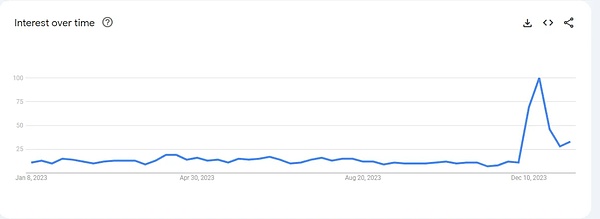 The trend of searching Saga Phone in Google Trends
The trend of searching Saga Phone in Google Trends
Recently, the transformation of Solana’s emotions can be verified through the sales of SAGA mobile phones.Although the phone is rated as “the worst phone in 2023”, as the price of BONK rises, users who purchase mobile phones find that it can pay for themselves.The owner of the mobile phone is qualified to get Bonk’s AirDrop, making this phone a free encrypted native phone.Due to the limited number of mobile phones, similar to Bored Ah or other collectibles, traders began to realize the opportunity of arbitrage and the value of future AirDrop, so they were anxious to buy mobile phones.The demand has reached its peak, and the unpacking Saga mobile phone sells for more than $ 5,000 on Solana.
This situation shows that the mood around the Solana ecosystem has changed. Bonk is an example of MEME assets. Similar variants and WIF.However, relying on MEME assets alone may not help the ecosystem development.In fact, consumers’ demand for using products on Solana, such as getting points and potential AirDrop, is the main factor to change emotions.Two recent examples are Pyth and Jito.
Pyth Network provides one -as -on -one prophecy service, and increases Solana’s liquidity by using Airdrop token.JITO provides users with AirDrop to users who pledge SOL in JITO’s verification device client and use LST for DEFI activities.These AirDrop activities are more beneficial to small users and bring substantial value benefits to them.
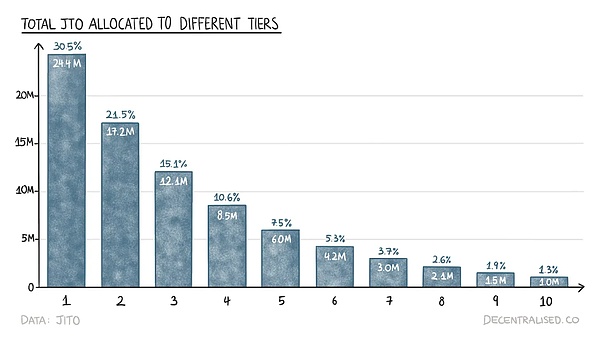 Allocate to the total JTO of different levels
Allocate to the total JTO of different levels
Interestingly, the Jito’s AirDrop solution adopts a layered mode, that is, from the first level to the tenth level, the number of JTO received by each point gradually decreases, showing a decreaseEssenceThis means that the lower the level of points, the higher the value of the points.
Jupiter is a DEX on Solana, which has disclosed the AirDrop program before Jito.Although people have realized that Jito will launch token, the size of AirDrop has been underestimated, which may be why AirDrop has not been used in large quantities.
Everyone is focusing on Solana, and everyone is trying to participate in the next JTO AirDrop.Some items such as Tensor, Kamino, Marginfi, Zeta, Meteora, ParCl, etc. have announced their points plans and converted these points into their own token.Some people think that these points plans are not a good idea, but there are also objections that they can be distributed as loyal points and more transparent token distribution, and they can unlock the behavior of increasing product value.
For example, Marginfi allocates one points to pledged users a day, but allocate four points a day to borrowing users.This system has its reasonableness because the agreement needs a borrower.Nevertheless, the detection Sybil activity is now very challenging, but there is a detection method such as Marginfi and Zeta. For example, if a wallet is matched with the money laundering trading model on Zeta, its points will be set to zero.
These examples have attracted a large number of users to join the ecosystem.In our opinion, the construction of ecosystems includes two balanced power.On the one hand, you need to be able to build culture and passion, and the problem of assets, points and AirDrop solves this problem.On the other hand, you need to design excellent products to attract people’s curiosity and maintain users.Therefore, although it can further explore all aspects of Solana, it should be more concerned about the products established by developers in the past year.
04Ecosystem
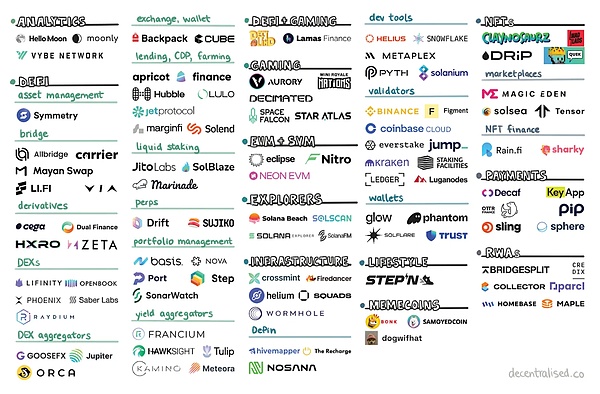 Solana’s chain ecological layout (incomplete version)
Solana’s chain ecological layout (incomplete version)
The development of Internet products is always accompanied by the improvement of bandwidth.The same is true in Web3. Solana marks a moment that its high throughput and low transaction costs make it possible to make consumption -level applications.Just like the platform we saw in the Web2 era bears the cost of the server.On Solana, compressing NFT allows developers to send one million NFTs by paying hundreds of dollars.
At present, most of the content on Solana is an extension of a wider range of cryptocurrency landscapes, which are regarded as “X, cheaper and faster”.However, to build a new application, it takes a lot of resources with the inherent behavior of users, which requires a lot of resources, and most startups are unwilling to challenge.
However, my excitement for Solana is that it is likely to change the current pattern of the Internet.I will introduce how it is realized in detail at the end of the article, but now, let’s take a look at the current situation of Solana.
1) Trading platform
Considering the relationship between Solana and FTX, early ecosystems were mainly concentrated on DEFI.Mercurial was originally a stable asset exchange platform on Solana, similar to Curve on Ethereum.After the collapse of FTX, hackers stole token worth more than $ 400 million from FTX, of which about 800,000 US dollars were Mercurial’s governance token Mer.This has led to the developer and Alameta Research.As part of restoration of development, Mercurial was abandoned and two new protocols were born: Jupiter and Meteora, which are income polymer and DEX polymer.
Solana’s low costs make it easier for users to trade at higher frequencies, which can be easily seen from the numbers.The three charts tell the differences between Ethereum and Solana.As far as transaction volume and lock value (TVL) is concerned, Ethereum shows superior indicators.
It should be noted that Ethereum has a five -year leading advantage and has a healthy DEFI ecosystem. The value of multiple basic Token has reached billions of dollars.Therefore, there are some defects below.When observing the chart, you should draw conclusions by checking all three charts instead of a single chart.
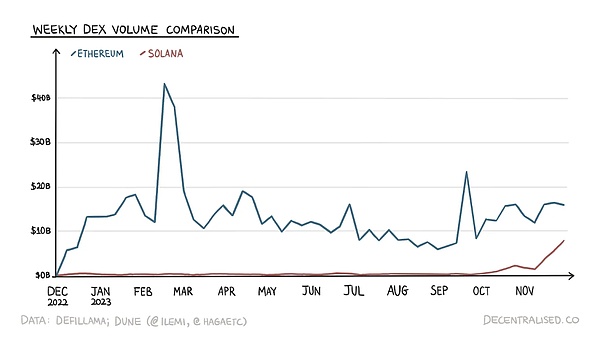 The transaction volume comparison of Ethereum and Solana
The transaction volume comparison of Ethereum and Solana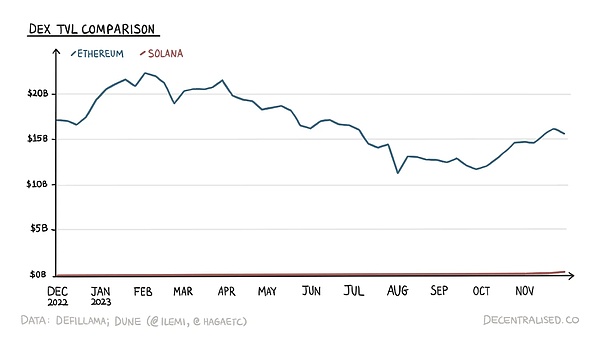 Ethereum and Solana’s TVL comparison
Ethereum and Solana’s TVL comparison
However, on the two chains, the difference in TVL is far greater than the transaction volume.At some point, the number of TVL is not so important.The higher the transaction volume to the TVL ratio, the better the capital efficiency.Recently, Solana has obviously performed better than Ethereum in this regard.
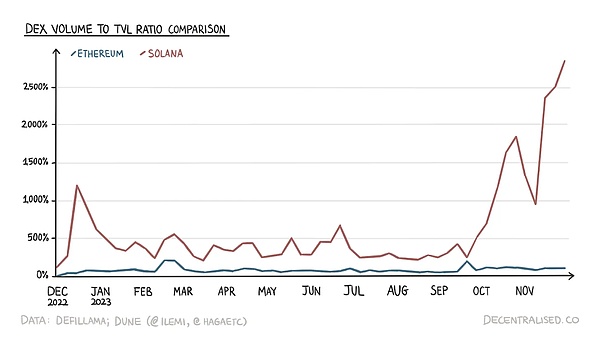 Ethereum and Solana transaction volume to TVL ratio
Ethereum and Solana transaction volume to TVL ratio
One of the reasons for the recent increase in transaction volume is that users want to get AirDrop.Jupiter announced the AirDROP plan, of which 50%of the Token retained to the community, divided into four different stages, the first stage may be launched in early 2024.
Although AirDrop may be the reason for promoting Solana activities, it must be understood that some designs on Ethereum are impossible.For example, the design of order books is impossible on the basic layer of Ethereum.A protocols such as DydX and AEVO have been branched on their own chain.
The combination of Solana’s speed and low cost means that the marketor can conduct high -frequency transactions on the chain without having to resort to CEX or wait for the second -layer solution for performance.
Many CEXs have almost no contact chain today.Sometimes, when chain integration is difficult, they just add token and prohibit the deposit or withdrawal of the token.However, CEX also has its advantages. As a city merchant (MM), CEX still chooses CEX as the main activity platform, not only because of the handling fee, but also because of performance assurance.
As people say, liquidity breeding liquidity.Traders rushed to the platform where the most municipal merchants were made because they were relatively easy to enter and exit large positions.
2) Borrowing and income polymer
The market on the chain allows market participants to obtain asset returns.In addition, they also allow investors to convert from one asset to another without incidents of taxable incidents.Marginfi is the most valuable borrowing agreement on Solana, which locks more than $ 350 million in deposits and $ 80 million borrowings.
Before FTX closed down, Solend was the main borrowing agreement on Solana.In November 2021, its total lock value was almost nearly $ 1 billion.In November 2022, when the FTX moved towards the bankruptcy, the price of the Solana ecosystem token plummeted, resulting in the position in the DEFI protocol was liquidated.The total lock value of Solend has dropped from more than 350 million US dollars to about 25 million US dollars, which only took a week.
As of December 26, 2023, the total locking value was only slightly higher than 200 million US dollars, and it has not yet returned to the level before the FTX closure.Solend’s lock value decline has created opportunities for a new agreement to attract funds.Considering that solend has token, it is not enough to attract and retain users by interest rates.
Marginfi seized this opportunity and announced the launch of “points”, which means that in addition to obtaining interest, the depositer and borrower will also get AirDrop at a certain time in the future.Marginfi launched points on the first week of July 2023.Since October 15, Marginfi’s total lock value has increased from about 30 million US dollars to about 485 million US dollars in just two months, an increase of more than 10 times.
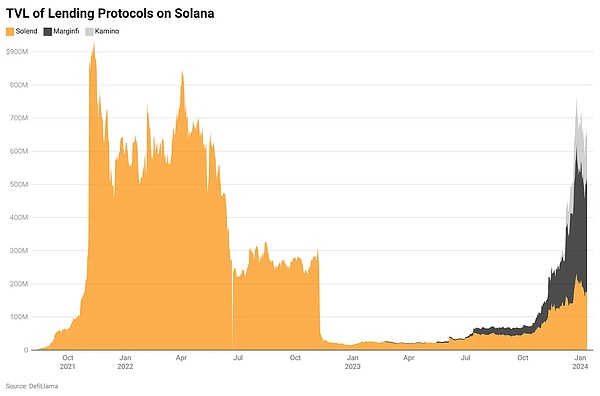 The total number of TVL on the agent protocol on the Solana
The total number of TVL on the agent protocol on the Solana
Kamino is the second largest borrowing platform on Solana, and its incentive mechanism shows the rapid growth of the platform.The agreement announced the upcoming points on December 3, and the total lock value of the total locking value has increased by 8 times within three weeks to approximately $ 245 million.
3) Moralbility
Praising is one of the core components of the equity certificate (POS) chain.It enables the pledged to obtain benefits from the inflation and expenses of the agreement and protect the security of the chain.Liquid pledge is the key infrastructure, because the chain should set a low threshold for pledge settings and should not reject users due to high costs.
Liquid pledge allows investors to pledge the amount of intention, without in -depth technical understanding or running node software.Although the authentication of Solana must pledge SOL from the beginning, and Ethereum did not start the rights and interests until last year, the liquid pledge industry on Ethereum was the lead.More than 383 million SOL was pledged, accounting for about 90%of the circulation supply.
Among them, there are amazing 362 million or about 95% of the patchwork, which means that it is locked and does not use any pledge derivatives.This means that users who pledged through the local SOL missed the opportunity to use the flow token for DEFI.If SOL pledge is performed by protocols like Marinade or Jito, you will get MSOL or Jitosol as a return, and you can use it in DEFI applications.With the development of pledge derivatives, people can expect users to gradually choose derivatives instead of taking the opportunity cost.
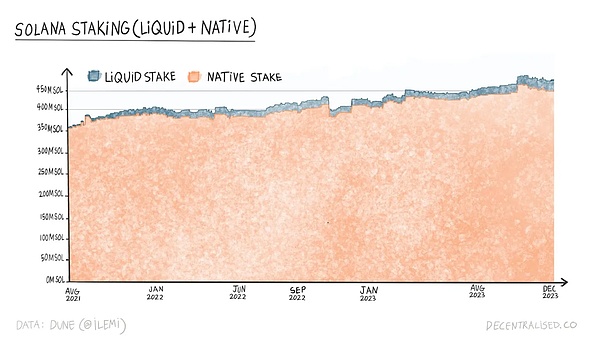 Sol’s pledge (liquidity and passiveness)
Sol’s pledge (liquidity and passiveness)
There are only about 20 million SOL in the liquid pledge market.At present, 24% of the circulation ETH is pledged, but about 68% (31% are LST and 37% are platforms) to pledge through the mobile pledge platform and CEX.If SOL also pledged 31% through different LST, Solana’s LST market can estimate about 115 million SOL or about 11 billion US dollars.
MarinaDe was the first Solana mobile pledge protocol that was born after the third place in the Sorana hacker marathon in 2021.The agreement was released on the main network in August 2021.The solution is similar to lido, simple and practical.When the user pledge SOL through MarinaDe’s pledged pool, the user will get the MarinaDe Sol or MSOL, which can be used in the DEFI application of Solana.
Msol has accumulated rewards obtained by the MarinaDe pledge pool and adjusted according to each period (about 2 days) relative to SOL.When the user uses a liquid pledged option for pledge, they must pay the pool.Liquid pledge allows users to face the risk of smart contracts for the pledge agreement.
MarinaDe also provides its users with the options for the SOL of the SOL.When they do this, the user will not get the return of MSOL.When users exercise this option, they use the function of the machine solana, and MarinaDe only acts as an interface.The user is the only person who can extract them at any time.
The user actually created a Solana pledged account and entrusted the responsibility of managing pledge to MarinaDe.At the end of each period of the pledge account, the pledge reward will be obtained.MarinaDe does not charge any fees to users, and they will not face MarinaDe’s smart contract risks.
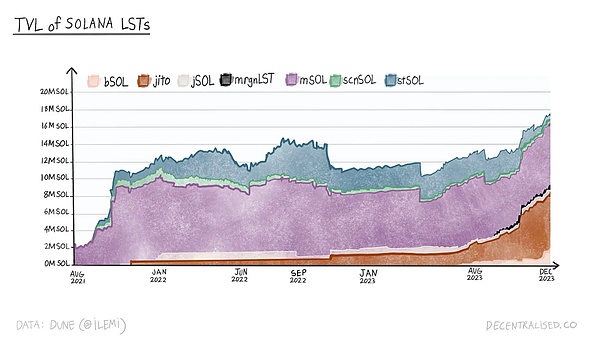 The total tvl of the liquidity pledge on solanas
The total tvl of the liquidity pledge on solanas
MarinaDe and Jito are the two mobile pledge protocol providers on Solana.MarinaDe’s total locking value is about 7.1 million SOL, and the market share is about 41%.The total locking value of JITO is about 6.4 million SOL, and the market share is about 38%.Similar to MARINADE’s MSOL, Jito provides Jitosol to users as vouchers that lock SOL in its pledge contract.In addition to the validator income, Jito also passed the MEV reward to the Jitosol holder.
The flow pledge token is very convenient for users, but there are some shortcomings.One of them is that liquidity may become a problem.For example, MSOL has disconnected from the anchor on December 12.When a trader sells a large amount of MSOL, the price fell from 1.16 to 1.02.This may be quite harmful for a token that should be “anchored”.Although the arbitrage enshrines the price to the anchor level, the incident highlights the necessity of improving the liquidity of liquidity to improve the liquidity of liquid pledge.
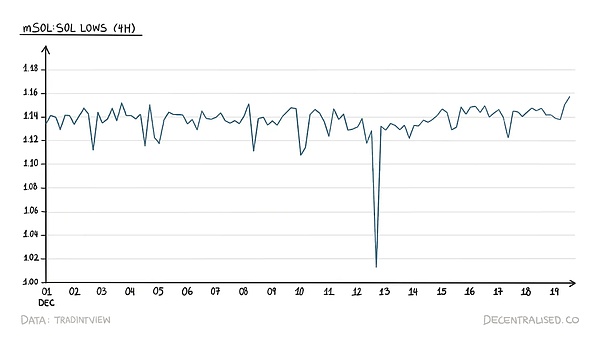 Msol appeared on December 12
Msol appeared on December 12
At present, there are more than 10 kinds of liquid pledged token on Solana.When more liquid pledge token is launched, the problem of low liquidity may become more serious.To solve this problem, Sanctum proposed a solution.SANCTUM Infinity is a multi -liquid pledged token pool that allows all liquid pledged token in the pool to exchange.This can be regarded as a polymerization layer of the Solana mobile pledge token.The solution is expected to be launched in the first quarter of 2024.
4) NFT ecosystem
The NFT ecosystem on Solana has developed rapidly in the past year.At first, lack of content that can be displayed, and some flagship projects such as Degods and Yoots chose to migrate to other chains.Although Magic Eden has always been the leading NFT market on Solana, it has hedged through multi -chain.The leading NFT collection is important for the community, so this gap must be filled.
New collectibles such as Claynosaurz and MAD LADS fill this gap, and have established a strong sense of belonging in the two communities because they choose to stay in SolanaEssenceThe common point of these two projects is that they are the means to achieve goals, not the end.
MAD LADS is a collection of former FTX engineers, which aims to replace FTX by another platform named Backpack.The intersection platform should fill the blank left by FTX, and at the same time more in line with regulations, higher transparency, and follow the spirit of DEFI.MAD LADS has developed a Solana wallet that uses the executable NFT or XNFT, which blur the boundary between the application and the NFT.
Unlike the traditional NFT, XNFT can execute the code.XNFT allows users to interact with applications such as JITO Staking, Birdeye, ORCA, and Marginfi in the Backpack wallet.
Magic Eden was originally a dominant NFT market on Solana.It expanded its support for Ethereum in August 2022 and eventually added other chains, such as Polygon and Bitcoin (INScriptions).When the Magic Eden expansion supports other chains,Tensor focuses on Solana and provides additional features.Such as tradingView integration and market orders.In addition to these features, Tensor also launched points similar to BLUR, and traders will get Tensor’s governance token as a reward.
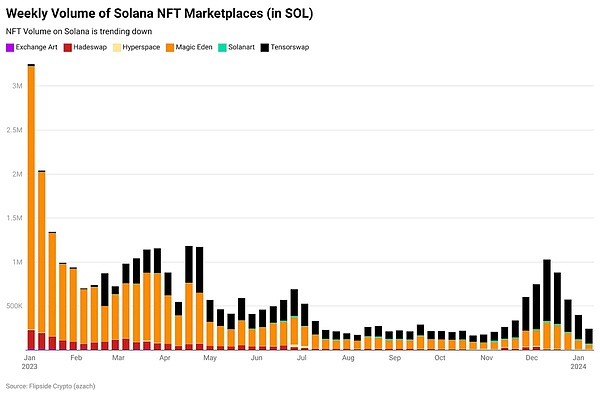 Weekly transaction volume in the NFT market on solana
Weekly transaction volume in the NFT market on solana
5) Infrastructure
I have been using Solana for more than two years, and I have experienced changes in infrastructure.Solana stopped from more than ten times in 2022, but only once in 2023.Although this failure does not want to happen, it is common for the new chain of attempt on cutting -edge technology.These faults occur even when the traffic is surging in L2 like ARBITRUM.
Various factors help improve infrastructure, from the operation of the cost market and client diversity to the RPC node.Companies such as Helius Labs and Triton are helping application developers with the following services:
-The RPC node and webhook that interacts with Solana network.Outsourcing this responsibility allows developers to focus more on solving core issues.
-In enhanced APIs to help developers save time to obtain the required data, such as trading history, NFT data, token metadata, etc.
Another infrastructure change is state compression. Solana uses Merkle trees and stores only some data, which greatly reduces the storage cost.NFT is one of the original applications of state compression.Helius Labs and Triton provide the necessary RPC node infrastructure and index services, while wallets such as Phantom and Solflare provide users with friendly interface.
The casting cost of 1 million NFT in Solana was about $ 247, and about $ 98,000 on Polygon, and about $ 650,000,000 on Ethereum.Drip is a NFT platform that sends 3 million NFTs to different users per week instead of showing advertisements to them.Through status compression technology, DRIP can achieve the same effect with about $ 250.
Some projects are improving the connection between Solana and his chain, and the best components of Solana and other chains are mixedEssenceEclipse uses Solana’s virtual machine SVM to calculate and use Ethereum as its settlement layer.In contrast, Neon is building EVM on Solana, which can be processed in parallel.Nitro is building COSMOS L2.
5) DEPIN
DEPIN represented a decentralized physical infrastructure network, which has been used to use decentralized infrastructure and inserted token incentives for a long time.DEPIN blurred the boundaries between consumers and commercial equipment.Helium and HiveMapper are some examples of DEPIN on Solana.
Helium’s initial mission was to create a decentralized wireless infrastructure to support IoT devices.Helium’s device is a hot spot, and about 50 hotspots are enough to provide an Internet connection for a city.Anyone can host a Helium hotspot.
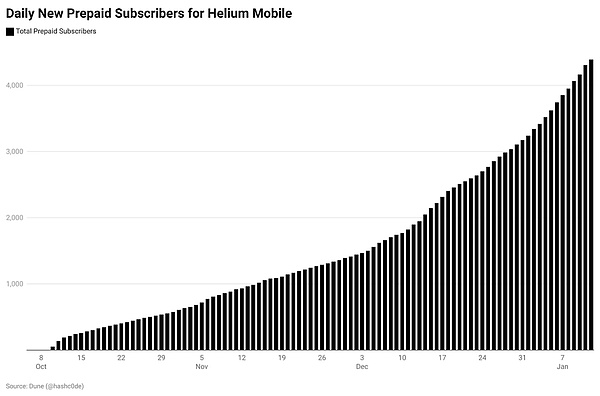 Helium Mobile’s daily prepaid user
Helium Mobile’s daily prepaid user
Helium had its own blockchain before moving to Solana in April 2023, and has more than one million hotspots.In order to support growth and further expansion, Helium outsourced the tasks such as infrastructure support to Solana to save costs and achieve better scalability.
HiveMapper is an example of another DEPIN application built on Solana.It helps to draw the world map by installing the driving recorder and use Honey Token to motivate participants.So far, HiveMapper has drawn a road worth 100 million kilometers, of which 6.6 million kilometers are unique.
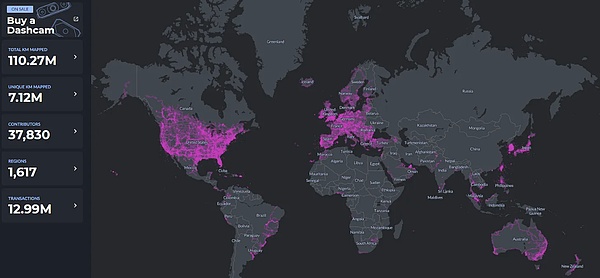 Source: hivemapper
Source: hivemapper
HiveMapper uses the motivation provided by Web3 infrastructure by inspiring ordinary people to install driving recorders and start drawing maps.This model makes services similar to Uber and Zomato in the future. In the future, they can use HiveMapper like Google Maps, and they need less permissions at the same time.
05summary
When the cost of interacting with products is decreased sharply, the use of technology will accelerate.We have experienced this. In the early 2000s, the cheap Nokia mobile phone replaced a fixed telephone connection, and people gradually switched to mobile phones.The development of Moore’s Law and Android allows people around the world to access the Internet through mobile devices.In my opinion, Solana’s features are very suitable for attracting the public.
You can ignore the other content of this article, and try to receive $ 1 in the Phantom wallet in Solana, you can understand what I mean.I still remember when I first experienced it, the closest speed and experience were what I saw when I used PayPal in the early 2010s.Solana’s unit economics allows developers to pay the cost of user interaction on the chain without having to leave large holes in the balance sheet.Solana’s unit economics makes it possible to build consumer scale beyond the field of encrypted native users today.
This does not mean that products like Marginfi or Jupiter have nothing to do with.They are the key infrastructure. However, to attract the first batch of users, they need to meet their needs and replacing existing financial infrastructure is a difficult but worthy of pursuit.However, when I look forward to the next ten years, unless we establish Facebook and Substack in our time, it will be difficult for us to obtain correlations in addition to a small part of the speculators.
Blockchain is financial infrastructure.In the current form, we excessively emphasize user transactions, rather than perform value exchange at the back endEssenceWhat form of value exchange can the blockchain of Solana achieve (do you know)?These answers exceed the scope of this article.
Like most prices rising, it is impossible to focus on the main matters, but to pay too much attention to the price, which will lead to the long -term advantage of the Internet.Therefore, Solana must slow down the pace of competing with EVM to turn to consumers.It requires a group of new venture capital companies that they are willing to invest in consumer encryption applications with the founders established in Web2 in the past.When the market stubbornly compete for the share of users on the 10 million active chain, this method of finding other directions may cause Solana to take a completely different trajectory.
In a fiercely competitive market, Solana found herself in a relatively strong position.Whether this will be transformed into meaningful trenches and continuous driving forces is unclear.But at present, the following points are obvious: the SVM method has an advantage when developing the network. Developers are building cool things in the ecosystem, and the community cares about everything.
These things did not happen overnight.Solana experienced suffering and returned.But please note that this does not mean that its goal needs to wait to be observed.

